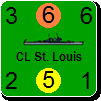color
Posts: 324
Joined: 7/24/2001
From: Oslo, Norway
Status: offline

|
... so.. having explained the theory of this, let me elaborate a little on the test I am currently running.
I picked up and old turn from the first CG I played. In this game I applied the strategy of hold ground and only retreat when forced to.
Version 1.01 against Soviet AI, with the difficulty level set to CHALLENGING.
The first game blizzard went really bad, heavy losses and much territory lost. As of mid june 42, about half of my divisions are still trying to recover from the winter and still unsure if I want to undertake any offensive action in 42. Some pz divisions still only have 30-40 tanks.
So with this in mind I picked up the first blizzard turn of '41 = the 1st turn in december, and started to apply the 'rubber band' defence.
So far I have completed until 1.1.42, and it's been interesting.
The frontlines have moved considerably, more than in the originalk game. But I have had very few retreats with high losses.
My forces have managed a high % of holds, especially against the 2nd line of defence. Surprisingly high number.
I suspect that to be the result of the russian only being able to execute hasty attacks against the second line.
Come 1.1.42 my force still feels OK, and some strenght seem to be returning. It's going to be interesting to see how it ends in march '42.
Even though I have had some limited success I still have noticed that I was loosing a substanstially high number of manpower each turn, still around 100.000. This puzzled me, and got me curious as to how heavy the attrition really is.
As a result decided to run some more test. Using the same dec. '41 turn, I ran two more games, both sides human, until 1.1.42.
In the first I left the frontlines as is, and no troops attacking. The result of that was surprising as I was experiencing even higher losses with no action whatsoever, compared to when I applied the 'rubber band' strategy.
Knowing that being in the frontline attritions units and that they loose a much higher number of damaged elements I figured that must be the culprit. So I decided to run a second scenario.
In the second scenario, I made the russians vacate ALL frontline hexes, and no attacks were executed. In other words, I removed casualties from attacks and casualties from frontline attrition. The only factor I know then is blizzard attrition (and there is probably some other small attrition as well). The resulting casualty number is very interesting.
So now I got 4 sets of numbers, all from the same 4.12.41 turn until 1.1.42, using different scenarios. See attached image.
The first column shows the loss numbers as they were on the first turn. Note all loss numbers are in 100k chunks.
The 4 following columns shows the result as of 1.1.42 for the following four test scenarios:
- No attacks & No enemy units adjacent, so both those casualties elements are removed. Only blizzard casualties (that I know of).
- Static frontline, no attacks. Casualties are from blizzard and frontline attrition.
- Normal gameplay using the rubber band strategy.
- Normal gameplay from the original game.
The green numbers are the total losses in each scenario for the period (4.12 - 1.1).
The red numbers are the casualties losses in the three last scenarios minus the 'only blizzard attrition'. I.e. the red numbers show what additional casualties were added in those scenarios apart from the blizzard effect (from scenario one).
An lastly the % of losses in the period that can be atttributed to combat or frontline attrition, with the remaining percentage being the blizzard attrition.
It's going to be interesting to see what I end up with in 1.3.42. As for now I have some observations:
- The german 'blizzard only' losses at 283 seem rather high. Until I understand what this number actually contains I'm going to refrain from comments.
- The losses from the 'rubber band' strategy which means there are combat losses, are actually lower that the static frontline losses! Very interesting, and I interpret that to the static frontline attrition losses and the rule that damaged elements of units adjacent to enemy units are much more likely to be destroyed. Seems that the strategy of keeping the enemy away from the bulk of the forces has actually had some effect.
Will get back with more data and comments when I have finalized all test to 1.3.42. 

 Attachment (1) Attachment (1)
|
 Printable Version
Printable Version






















 New Messages
New Messages No New Messages
No New Messages Hot Topic w/ New Messages
Hot Topic w/ New Messages Hot Topic w/o New Messages
Hot Topic w/o New Messages Locked w/ New Messages
Locked w/ New Messages Locked w/o New Messages
Locked w/o New Messages Post New Thread
Post New Thread